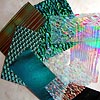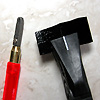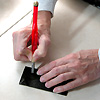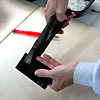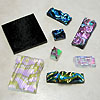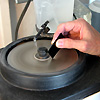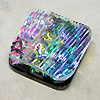- sale
- new items
- lovely beads
- wedding beads
- beads for teens
- for custom order
- newsletter
- recognition
- testimonials
- birthstones
- zodiac signs
- jewelry guide
SHOP BAG
![]() in your bag 0 items
in your bag 0 items

Dichroic glass is glass containing multiple micro-layers of metal oxides which give the glass dichroic optical properties. The process of cutting and preparing the glass is quite simple. The basic tools and materials required can be purchased from a stained glass supplier or a ceramic supply store that is involved with fusing:
- glasscutter - this puts a "scratch" on the glass where it is to be broken;
-
pliers - special curved pliers that when placed over the "scratch" break
the glass along that line; -
grinder - used to shape the glass (I use a flat top Hi-Tech Diamond Grinder);
bit rotary grinders are useful for creating curves; -
glass - must be compatible meaning it must have the same COE (Coefficient
of Expansion); I use COE 90 glass.
The glass is prepared in layers of two to four different types and colors of glass. Because of its reflective properties, dichroic glass often will only show its brilliant colors when placed on top of black, so a black glass backing is often used. Dichroic glass can be purchased layered on black glass or on clear glass. This allows for a lot of variety and unusual results.
You begin by making a backing. Take a piece of black glass (or dichroic glass already placed on black glass) and cut it to the size you want using the glasscutters and pliers. If you want the corners rounded, you can use the flat grinder to round them. Once you have the backing glass sized and shaped like you want, choose the dichroic glass you want for your second layer.
You can use many different kinds and colors of glass placed next to each other or one specific type of dichroic glass for the whole 2nd layer. This is where your creativity and imagination come into play. The top layer is either another piece of dichroic glass layered on clear glass or just plain clear glass. If dichroic glass is placed on top, the finish will be metallic. If clear glass is used, the finish will be shiny glass.
Once you have finished shaping and layering your glass, it must be thoroughly cleaned to remove any oil and dirt. I use warm soapy water, but purchased glass cleaners can also be used. After cleaning, the pieces are stacked up once again and placed in the kiln for fusing and annealing.
If you don't have a kiln, you can contact a store that deals with glass fusing or stained glass and they may offer a program for firing your pieces for you. If you want to purchase your own kiln, you will need to research the many different kinds of kilns available and choose the one that best suits your needs.
In addition to a kiln you will need a removable kiln shelf, kiln shelf paper and kiln wash. The glass cabochons are not placed on the kiln floor as they would stick to it. They are placed on the kiln shelf which is covered either in kiln wash or kiln shelf paper. The bottom of the cabs will take the shape of whatever they are lying upon, so the kiln shelf paper or kiln wash provide a smooth surface.
In order to properly fuse and anneal the glass, it must be slowly heated and slowly cooled. If glass is heated or cooled too quickly it will break because of thermal shock. Large or thick pieces of glass need more time to heat and cool evenly than thin or small pieces.
There are basically four zones of heat that affect the glass. The first zone of heating takes the glass slowly up to around 700-750 degrees. This is the zone where thermal shock can occur. The second zone is roughly from 700- 1100 degrees. During this zone, the glass is changing and has characteristics of pudding or jelly that is setting up. Glass is less sensitive to thermal shock in this range.
The third stage is from roughly 1000-1300 degrees. The glass becomes flexible, somewhat like taffy and is affected by manipulation or gravity. Slumping occurs in this stage. The final zone is 1300 degrees and up. It is during this stage that fusing occurs. The glass melts together into a single mass.
The rate of heating and cooling needs to be controlled and altered in the different zones. During the cooling process, the glass is annealed during the transition zone of 1100 to 750 degrees. If the glass is cooled too quickly during this stage, it may develop internal stress that will cause unwanted breakage. The kiln should not lose more than 80 degrees of heat every 10 minutes. If it cools slower than that, no problem. You cannot overanneal glass.
The process of creating dichroic glass cabochons
My gallery on MyLovelyBeads.com
About author:
| Linda Roberts, San Diego, California, USA | |
| Email address: | llroberts9@gmail.com |
| Website: | www.myheartbeadsforyou.com |
| Gallery on Flickr: | flickr.com/people/beadsforever |
| Blog: | beadsforever2.blogspot.com |
| Etsy Shop: | www.beadsforever.etsy.com |


